Name John Napier Fields Mathematician | ||
Known for LogarithmsNapier's bonesDecimal notation Parents Janet Bothwell, Archibald Napier Books A Description of the Ad, Charismatic Challenge: Four Key, Hands, Ghost in a Coal Mine II: Portal t, A Ghost in a Coal Mine Similar People William Oughtred, Wilhelm Schickard, Herman Hollerith, Joseph Marie Jacquard, Henry Briggs | ||
John napier
John Napier of Merchiston (; 1 February, 1550 – 4 April 1617); also signed as Neper, Nepair; nicknamed Marvellous Merchiston) was a Scottish landowner known as a mathematician, physicist, and astronomer. He was the 8th Laird of Merchiston. His Latinized name was Ioannes Neper.
Contents
- John napier
- John napier s mathematical creations mathematical models from sundials to number engines 6 7
- Early life
- Advances in mathematics
- Theology
- The occult
- Influence
- Eponyms
- Family
- List of works
- References
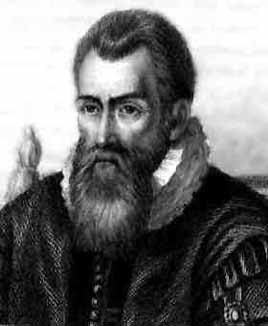
John Napier is best known as the discoverer of logarithms. He also invented the so-called "Napier's bones" and made common the use of the decimal point in arithmetic and mathematics.
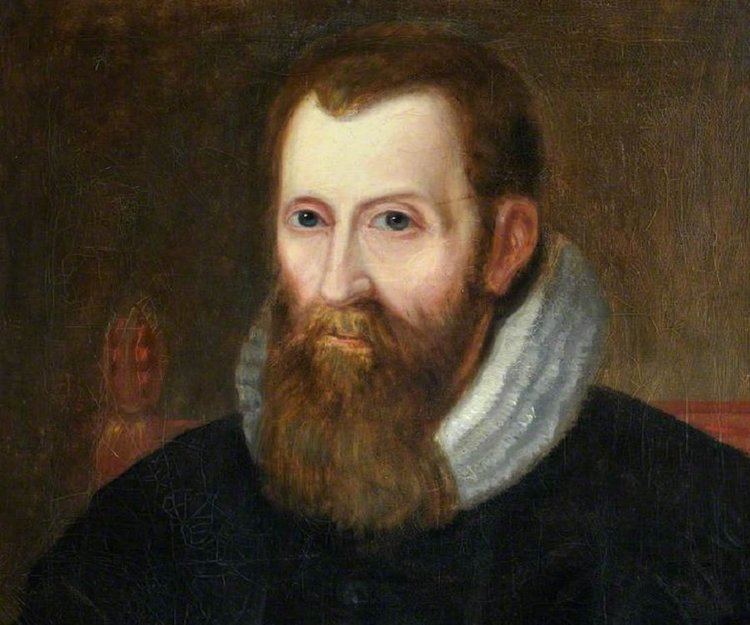
Napier's birthplace, Merchiston Tower in Edinburgh, is now part of the facilities of Edinburgh Napier University. Napier died from the effects of gout at home at Merchiston Castle and his remains were buried in the kirkyard of St Giles. Following the loss of the kirkyard there to build Parliament House, he was memorialised at St Cuthbert's at the west side of Edinburgh.
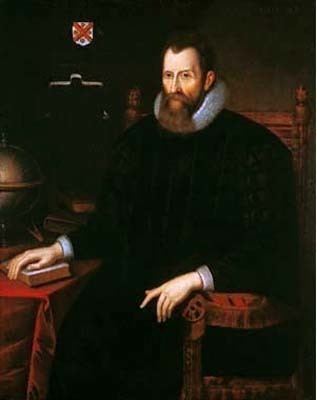
John napier s mathematical creations mathematical models from sundials to number engines 6 7
Early life
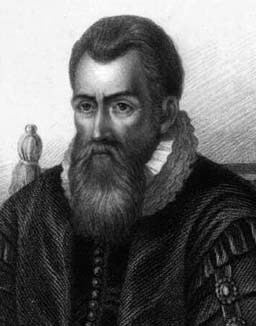
Napier's father was Sir Archibald Napier of Merchiston Castle, and his mother was Janet Bothwell, daughter of the politician and judge Francis Bothwell, Lord of Session, and a sister of Adam Bothwell who became the Bishop of Orkney. Archibald Napier was 16 years old when John Napier was born.
As was the common practice for members of the nobility at that time, he was privately tutored and did not have formal education until he was 13, when he was sent to St Salvator's College, St Andrews. He did not stay in college very long. It is believed that he dropped out of school in Scotland and perhaps travelled in mainland Europe to better continue his studies. Little is known about those years, where, when, or with whom he might have studied, although his uncle Adam Bothwell wrote a letter to John's father on 5 December 1560, saying "I pray you, sir, to send John to the schools either to France or Flanders, for he can learn no good at home", and it is believed that this advice was followed.
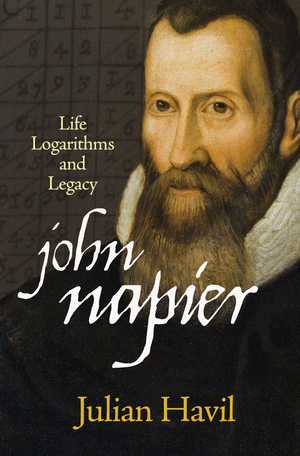
In 1571, Napier, aged 21, returned to Scotland, and bought a castle at Gartness in 1574. On the death of his father in 1608, Napier and his family moved into Merchiston Castle in Edinburgh, where he resided the remainder of his life. He died at the age of 67. In such conditions, it is hardly surprising that many mathematicians were acutely aware of the issues of computation and were dedicated to relieving practitioners of the calculation burden. In particular, the Scottish mathematician John Napier was famous for his devices to assist with computation. He invented a well-known mathematical artifact, the ingenious numbering rods more quaintly known as “Napier's bones,” that offered mechanical means for facilitating computation. (For additional information on “Napier's bones,” see the article, “John Napier: His Life, His Logs, and His Bones” (2006).) In addition, Napier recognized the potential of the recent developments in mathematics, particularly those of prosthaphaeresis, decimal fractions, and symbolic index arithmetic, to tackle the issue of reducing computation. He appreciated that, for the most part, practitioners who had laborious computations generally did them in the context of trigonometry. Therefore, as well as developing the logarithmic relation, Napier set it in a trigonometric context so it would be even more relevant.
Advances in mathematics
His work, Mirifici Logarithmorum Canonis Descriptio (1614) contained fifty-seven pages of explanatory matter and ninety pages of tables of numbers related to natural logarithms (see Napierian logarithm). The book also has an excellent discussion of theorems in spherical trigonometry, usually known as Napier's Rules of Circular Parts. Modern English translations of both Napier's books on logarithms and their description can be found on the web, as well as a discussion of Napier's Bones (see below) and Promptuary (another early calculating device). His invention of logarithms was quickly taken up at Gresham College, and prominent English mathematician Henry Briggs visited Napier in 1615. Among the matters they discussed were a re-scaling of Napier's logarithms, in which the presence of the mathematical constant e (more accurately, e times a large power of 10 rounded to an integer) was a practical difficulty. Napier delegated to Briggs the computation of a revised table. The computational advance available via logarithms, the converse of powered numbers or exponential notation, was such that it made calculations by hand much quicker. The way was opened to later scientific advances, in astronomy, dynamics, and other areas of physics.
Napier made further contributions. He improved Simon Stevin's decimal notation. Lattice multiplication, used by Fibonacci, was made more convenient by his introduction of Napier's bones, a multiplication tool using a set of numbered rods.
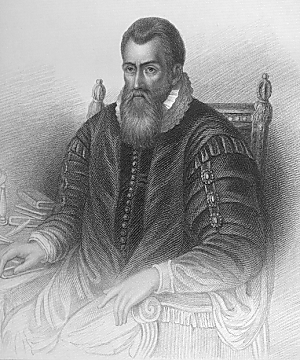
Napier may have worked largely in isolation, but he had contact with Tycho Brahe who corresponded with his friend John Craig. Craig certainly announced the discovery of logarithms to Brahe in the 1590s (the name itself came later); there is a story from Anthony à Wood, perhaps not well substantiated, that Napier had a hint from Craig that Longomontanus, a follower of Brahe, was working in a similar direction. It has been shown that Craig had notes on a method of Paul Wittich that used trigonometric identities to reduce a multiplication formula for the sine function to additions.
Theology
Napier had an interest in the Book of Revelation, from his student days at St Salvator's College, St Andrews. Under the influence of the sermons of Christopher Goodman, he developed a strongly anti-papal reading. He further used the Book of Revelation for chronography, to predict the Apocalypse, in A Plaine Discovery of the Whole Revelation of St. John (1593), which he regarded as his most important work; he also applied the Sibylline Oracles, to calculate the date of the end of the world. Napier believed that would occur in 1688 or 1700. He dated the seventh trumpet to 1541.
In his dedication of the Plaine Discovery to James VI, dated 29 Jan 1594, Napier urged the king to see "that justice be done against the enemies of God's church," and counselled the King "to reform the universal enormities of his country, and first to begin at his own house, family, and court." The volume includes nine pages of Napier's English verse. It met with success at home and abroad. In 1600 Michiel Panneel produced a Dutch translation, and this reached a second edition in 1607. In 1602 the work appeared at La Rochelle in a French version, by Georges Thomson, revised by Napier, and that also went through several editions (1603, 1605, and 1607). A new edition of the English original was called for in 1611, when it was revised and corrected by the author, and enlarged by the addition of With a resolution of certain doubts, moved by some well affected brethren.; this appeared simultaneously at Edinburgh and London. The author stated that he still intended to publish a Latin edition, but it never appeared. A German translation, by Leo de Dromna, of the first part of Napier's work appeared at Gera in 1611, and of the whole by Wolfgang Meyer at Frankfurt-am-Main, in 1615. Among Napier's followers was Matthew Cotterius (Matthieu Cottière).
The occult
In addition to his mathematical and religious interests, Napier was often perceived as a magician, and is thought to have dabbled in alchemy and necromancy. It was said that he would travel about with a black spider in a small box, and that his black rooster was his familiar spirit.
A contract still exists for a treasure hunt, made between Napier and Robert Logan of Restalrig. Napier was to search Fast Castle for treasure allegedly hidden there, wherein it is stated that Napier should "do his utmost diligence to search and seek out, and by all craft and ingine to find out the same, or make it sure that no such thing has been there."
Influence
Among Napier's early followers were the instrument makers Edmund Gunter and John Speidell. The development of logarithms is given credit as the largest single factor in the general adoption of decimal arithmetic. The Trissotetras (1645) of Thomas Urquhart builds on Napier's work, in trigonometry.
Eponyms
An alternative unit to the decibel used in electrical engineering, the neper, is named after Napier, as is Edinburgh Napier University in Edinburgh, Scotland.
The crater Neper on the Moon is named after him.
Family
In 1572, Napier married 16-year-old Elizabeth, daughter of James Stirling, the 4th Laird of Keir and of Cadder. They had two children. Elizabeth died in 1579, and Napier then married Agnes Chisholm, with whom he had ten more children. His father-in-law James Chisholm of Cromlix was later mixed up in the Spanish blanks plot, over which Napier with others petitioned the king.
List of works
Early life
Napier's father was Sir Archibald Napier of Merchiston Castle, and his mother was Janet Bothwell, daughter of the politician and judge Francis Bothwell, Lord of Session, and a sister of Adam Bothwell who became the Bishop of Orkney. Archibald Napier was 16 years old when John Napier was born.
As was the common practice for members of the nobility at that time, he was privately tutored and did not have formal education until he was 13, when he was sent to St Salvator's College, St Andrews. He did not stay in college very long. It is believed that he dropped out of school in Scotland and perhaps travelled in mainland Europe to better continue his studies. Little is known about those years, where, when, or with whom he might have studied, although his uncle Adam Bothwell wrote a letter to John's father on 5 December 1560, saying "I pray you, sir, to send John to the schools either to France or Flanders, for he can learn no good at home", and it is believed that this advice was followed.
In 1571, Napier, aged 21, returned to Scotland, and bought a castle at Gartness in 1574. On the death of his father in 1608, Napier and his family moved into Merchiston Castle in Edinburgh, where he resided the remainder of his life. He died at the age of 67. In such conditions, it is hardly surprising that many mathematicians were acutely aware of the issues of computation and were dedicated to relieving practitioners of the calculation burden. In particular, the Scottish mathematician John Napier was famous for his devices to assist with computation. He invented a well-known mathematical artifact, the ingenious numbering rods more quaintly known as “Napier's bones,” that offered mechanical means for facilitating computation. (For additional information on “Napier's bones,” see the article, “John Napier: His Life, His Logs, and His Bones” (2006).) In addition, Napier recognized the potential of the recent developments in mathematics, particularly those of prosthaphaeresis, decimal fractions, and symbolic index arithmetic, to tackle the issue of reducing computation. He appreciated that, for the most part, practitioners who had laborious computations generally did them in the context of trigonometry. Therefore, as well as developing the logarithmic relation, Napier set it in a trigonometric context so it would be even more relevant.
Advances in mathematics
His work, Mirifici Logarithmorum Canonis Descriptio (1614) contained fifty-seven pages of explanatory matter and ninety pages of tables of numbers related to natural logarithms (see Napierian logarithm). The book also has an excellent discussion of theorems in spherical trigonometry, usually known as Napier's Rules of Circular Parts. Modern English translations of both Napier's books on logarithms and their description can be found on the web, as well as a discussion of Napier's Bones (see below) and Promptuary (another early calculating device). His invention of logarithms was quickly taken up at Gresham College, and prominent English mathematician Henry Briggs visited Napier in 1615. Among the matters they discussed were a re-scaling of Napier's logarithms, in which the presence of the mathematical constant e (more accurately, e times a large power of 10 rounded to an integer) was a practical difficulty. Napier delegated to Briggs the computation of a revised table. The computational advance available via logarithms, the converse of powered numbers or exponential notation, was such that it made calculations by hand much quicker. The way was opened to later scientific advances, in astronomy, dynamics, and other areas of physics.
Napier made further contributions. He improved Simon Stevin's decimal notation. Lattice multiplication, used by Fibonacci, was made more convenient by his introduction of Napier's bones, a multiplication tool using a set of numbered rods.
Napier may have worked largely in isolation, but he had contact with Tycho Brahe who corresponded with his friend John Craig. Craig certainly announced the discovery of logarithms to Brahe in the 1590s (the name itself came later); there is a story from Anthony à Wood, perhaps not well substantiated, that Napier had a hint from Craig that Longomontanus, a follower of Brahe, was working in a similar direction. It has been shown that Craig had notes on a method of Paul Wittich that used trigonometric identities to reduce a multiplication formula for the sine function to additions.
Theology
Napier had an interest in the Book of Revelation, from his student days at St Salvator's College, St Andrews. Under the influence of the sermons of Christopher Goodman, he developed a strongly anti-papal reading. He further used the Book of Revelation for chronography, to predict the Apocalypse, in A Plaine Discovery of the Whole Revelation of St. John (1593), which he regarded as his most important work; he also applied the Sibylline Oracles, to calculate the date of the end of the world. Napier believed that would occur in 1688 or 1700. He dated the seventh trumpet to 1541.
In his dedication of the Plaine Discovery to James VI, dated 29 Jan 1594, Napier urged the king to see "that justice be done against the enemies of God's church," and counselled the King "to reform the universal enormities of his country, and first to begin at his own house, family, and court." The volume includes nine pages of Napier's English verse. It met with success at home and abroad. In 1600 Michiel Panneel produced a Dutch translation, and this reached a second edition in 1607. In 1602 the work appeared at La Rochelle in a French version, by Georges Thomson, revised by Napier, and that also went through several editions (1603, 1605, and 1607). A new edition of the English original was called for in 1611, when it was revised and corrected by the author, and enlarged by the addition of With a resolution of certain doubts, moved by some well affected brethren.; this appeared simultaneously at Edinburgh and London. The author stated that he still intended to publish a Latin edition, but it never appeared. A German translation, by Leo de Dromna, of the first part of Napier's work appeared at Gera in 1611, and of the whole by Wolfgang Meyer at Frankfurt-am-Main, in 1615. Among Napier's followers was Matthew Cotterius (Matthieu Cottière).
The occult
In addition to his mathematical and religious interests, Napier was often perceived as a magician, and is thought to have dabbled in alchemy and necromancy. It was said that he would travel about with a black spider in a small box, and that his black rooster was his familiar spirit.
A contract still exists for a treasure hunt, made between Napier and Robert Logan of Restalrig. Napier was to search Fast Castle for treasure allegedly hidden there, wherein it is stated that Napier should "do his utmost diligence to search and seek out, and by all craft and ingine to find out the same, or make it sure that no such thing has been there."
Influence
Among Napier's early followers were the instrument makers Edmund Gunter and John Speidell. The development of logarithms is given credit as the largest single factor in the general adoption of decimal arithmetic. The Trissotetras (1645) of Thomas Urquhart builds on Napier's work, in trigonometry.
Eponyms
An alternative unit to the decibel used in electrical engineering, the neper, is named after Napier, as is Edinburgh Napier University in Edinburgh, Scotland.
The crater Neper on the Moon is named after him.
Family
In 1572, Napier married 16-year-old Elizabeth, daughter of James Stirling, the 4th Laird of Keir and of Cadder. They had two children. Elizabeth died in 1579, and Napier then married Agnes Chisholm, with whom he had ten more children. His father-in-law James Chisholm of Cromlix was later mixed up in the Spanish blanks plot, over which Napier with others petitioned the king.
